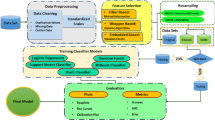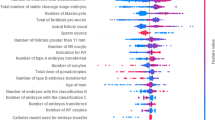Abstract
Infertility affects one out of seven couples around the world. Therefore, the best possible management of the in vitro fertilization (IVF) treatment and patient advice is crucial for both patients and medical practitioners. The ultimate concern of the patients is the success of an IVF procedure, which depends on a number of influencing attributes. Without any automated tool, it is hard for the practitioners to assess any influencing trend of the attributes and factors that might lead to a successful IVF pregnancy. This paper proposes a hill climbing feature (attribute) selection algorithm coupled with automated classification using machine learning techniques with the aim to analyze and predict IVF pregnancy in greater accuracy. Using 25 attributes, we assessed the prediction ability of IVF pregnancy success for five different machine learning models, namely multilayer perceptron (MLP), support vector machines (SVM), C4.5, classification and regression trees (CART) and random forest (RF). The prediction ability was measured in terms of widely used performance metrics, namely accuracy rate, F-measure and AUC. Feature selection algorithm reduced the number of most influential attributes to nineteen for MLP, sixteen for RF, seventeen for SVM, twelve for C4.5 and eight for CART. Overall, the most influential attributes identified are: ‘age’, ‘indication’ of fertility factor, ‘Antral Follicle Counts (AFC)’, ‘NbreM2’, ‘method of sperm collection’, ‘Chamotte’, ‘Fertilization rate in vitro’, ‘Follicles on day 14’ and ‘Embryo transfer day.’ The machine learning models trained with the selected set of features significantly improved the prediction accuracy of IVF pregnancy success to a level considerably higher than those reported in the current literature.





Similar content being viewed by others
References
Begg R, Kamruzzaman J (2005) A machine learning approach for automated recognition of movement patterns using basic, kinetic and kinematic gait data. J Biomech 38(3):401–408
Binder H, Schumacher M (2008) Adapting prediction error estimates for biased complexity selection in high-dimensional bootstrap samples. Stat Appl Genet Mol Biol 7(1):1–26 (Article 12)
Breiman L (1984) Classification and regression trees. Routledge, New York
Breiman L (1993) Classification and regression trees. CRC Press, Boca Raton
Breiman L (2001) Random forests. Mach Learn 45(1):5–32
Bustillo M, Stern JJ, King D, Coulam CB (1993) Serum progesterone and estradiol concentrations in the early diagnosis of ectopic pregnancy after in vitro fertilization-embryo transfer. Fertil Steril 59(3):668–670
Charalambous C (1992) Conjugate gradient algorithm for efficient training of artificial neural networks. IEE Proc G-Circuits Dev Syst 13(3):301–310
Choi B, Bosch E, Lannon BM, Leveille MC, Wong WH, Leader A, Pellicer A, Penzias AS, Yao MW (2013) Personalized prediction of first-cycle in vitro fertilization success. Fertil Steril 99(7):1905–1911
Corani G, Magli C, Giusti A, Gianaroli L, Gambardella LM (2013) A Bayesian network model for predicting pregnancy after in vitro fertilization. Comput Biol Med 43(11):1783–1792
Cutler DR, Edwards TC Jr, Beard KH, Cutler A, Hess KT, Gibson J, Lawler JJ (2007) Random forests for classification in ecology. Ecology 88(11):2783–2792
Demyttenaere K, Bonte L, Gheldof M, Vervaeke M, Meuleman C, Vanderschuerem D, D’Hooghe T (1998) Coping style and depression level influence outcome in in vitro fertilization. Fertil Steril 69(6):1026–1033
Ding CH, Dubchak I (2001) Multi-class protein fold recognition using support vector machines and neural networks. Bioinformatics 17(4):349–358
Durairaj M, Thamilselvan P (2013) Applications of artificial neural network for IVF data analysis and prediction. J Eng Comput Appl Sci 2(9):11–15
Durairaj M, Nandhakumar R (2014) An integrated methodology of artificial neural network and rough set theory for analyzing IVF data. In: 2014 International conference on intelligent computing applications (ICICA), pp 126–129
Fayyad UM, Piatetsky-Shapiro G G, Smyth P (1996) The KDD process for extracting useful knowledge from volumes of data. Commun ACM 39(11):27–34
Guh R, Wu TCJ, Weng SP (2011) Integrating genetic algorithm and decision tree learning for assistance in predicting in vitro fertilization outcomes. Expert Syst Appl 38(4):4437–4449
Güvenir HA, Misirli G, Dilbaz S, Ozdegirmenci O, Demir B, Dilbaz B (2015) Estimating the chance of success in IVF treatment using a ranking algorithm. Med Biol Eng Comput 53(9):911–920
Hafiz P, Nematollahi M, Boostani R, Bahia NJ (2017) Predicting implantation outcome of In Vitro fertilization and intracytoplasmic sperm injection using data mining techniques. Fertil Steril 11(3):184–190
Haykin S (2004) Neural network—a comprehensive foundation. Prentice Hall, New Jersey
Hoover L, Baker A, Check JH, Lurie D, O’Shaughnessy A (1995) Evaluation of a new embryo-grading system to predict pregnancy rates following in vitro fertilization. Gynecol Obstet Invest 40(3):151–157
Janecek A, Gansterer W, Demel M, Ecker G (2008) On the relationship between feature selection and classification accuracy. In: New challenges for feature selection in data mining and knowledge discovery, pp 90–105
Jurisica I, Mylopoulos J, Glasgow J, Shapiro H, Casper RF (1998) Case-based reasoning in IVF: prediction and knowledge mining. Artif Intell Med 12(1):1–24
Kaufmann SJ, Eastaugh JL, Snowden S, Smye SW, Sharma V (1997) The application of neural networks in predicting the outcome of in vitro fertilization. Hum Reprod 12(7):1454–1457
Kaur H, Krishna D, Shetty N, Krishnan S, Srinivas MS, Rao KA (2012) Effect of pre-ovulatory single dose GnRH agonist therapy on IVF outcome in GnRH antagonist cycles; a prospective study. J Reprod Infertil 13(4):225–231
Kohavi R (1995) A study of cross-validation and bootstrap for accuracy estimation and model selection. In: 14th International joint conference on artificial intelligence (IJCAI), vol 14(2), pp 1137–1143
Manna C, Nanni L, Lumini A, Pappalardo S (2013) Artificial intelligence techniques for embryo and oocyte classification. Reprod Biomed Online 26(1):42–49
Mascarenhas MN, Flaxman SR, Boerma T, Vanderpoel S, Stevens GA (2012) National, regional, and global trends in infertility prevalence since 1990: a systematic analysis of 277 health surveys. PLoS Med 9(12):e1001356
Milewski R, Milewska AJ, Wiesak T, Morgan A (2013) Comparison of artificial neural networks and logistic regression analysis in pregnancy prediction using the in vitro fertilization treatment. Stud Log Gramm Rhetor 35(1):39–48
Morales DA, Bengoetxea E, Larrañaga P, García M, Franco Y, Fresnada M, Merino M (2008) Bayesian classification for the selection of in vitro human embryos using morphological and clinical data. Comput Methods Programs Biomed 90(2):104–116
Nanni L, Lumini A, Manna C (2010) A data mining approach for predicting the pregnancy rate in human assisted reproduction. Adv Comput Intell Paradig Healthc 5:97–111
Platt J (1998) Sequential minimal optimization: a fast algorithm for training support vector machines, Microsoft Research Technical Report MSR-TR-98-14
Quinlan JR (1993) C4.5: programs for machine learning, vol 1. Morgan Kaufmann, San Francisco
Ramasamy N, Durairaj M (2017) Feature reduction by improvised hybrid algorithm for predicting the IVF success rate. J Adv Res Comput Sci 8(1):37–40
Schwarzer G, Vach W, Schumacher M (2000) On the misuses of artificial neural networks for prognostic and diagnostic classification in oncology. Stat Med 19(4):541–561
SMO Weka (2017) Optimizing parameters. https://weka.wikispaces.com/Optimizing+parameters. Accessed 20 Dec 2017
Uyar A, Bener A, Ciray HN, Bahceci M (2010) ROC based evaluation and comparison of classifiers for IVF implantation prediction. In: Electronic healthcare, pp 108–111
Uyar A, Ayse B, Ciray HN (2015) Predictive modeling of implantation outcome in an in vitro fertilization setting: an application of machine learning methods. Med Decis Mak 35(6):714–725
Vapnik VN (1998) Statistical learning theory. Wiley, New York
Author information
Authors and Affiliations
Corresponding author
Ethics declarations
Conflict of interest
The authors declare that they have no conflict of interest.
Rights and permissions
About this article
Cite this article
Hassan, M.R., Al-Insaif, S., Hossain, M.I. et al. A machine learning approach for prediction of pregnancy outcome following IVF treatment. Neural Comput & Applic 32, 2283–2297 (2020). https://doi.org/10.1007/s00521-018-3693-9
Received:
Accepted:
Published:
Issue Date:
DOI: https://doi.org/10.1007/s00521-018-3693-9




